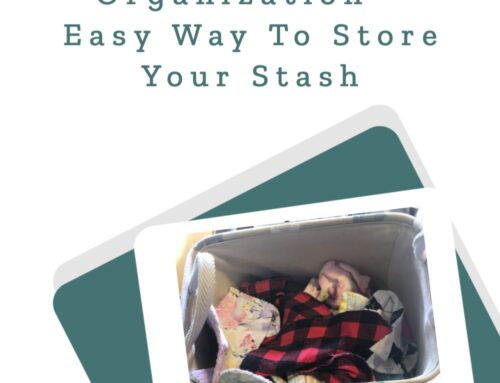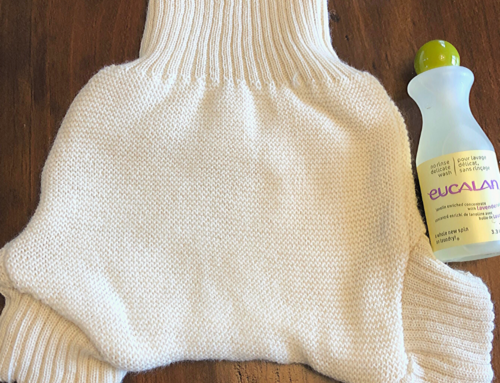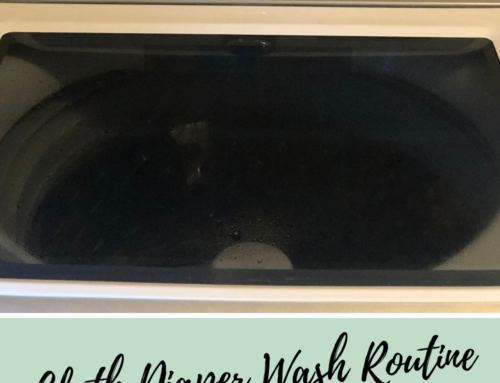Have you ever thought about washing your washing machine? The whole concept seems a little strange at first–I mean, don’t you put hot water and soap into it each day? Well, it’s actually a good practice to wash your washing machine every couple months. We talk about laundry quite a bit here at Rocking the Cloth, but even if you don’t use cloth diapers (and once your kids are out of the diaper stage), it’s still a good practice everyone should do. How you go about doing this may depend on your machine. This post will focus on how to clean a top loader washing machine.
Washing your washing machine is a good idea because there is leftover reside from detergent that gets left behind and starts to build up. You may also have some hard water mineral build up in places. Periodically cleaning your washing machine will allow your machine to wash your laundry much more efficiently.
Materials Needed

- Favorite spray cleaner and towel/rag (I use Force of Nature Cleaner!)
- Bleach (about 1-2 cups)
- Vinegar (about 4 cups)
(Note: The bleach and vinegar are not used at the same time. Using them together can actually be toxic. It is important that you do not try to combine steps for safety purposes).
Some people are uncomfortable with using bleach. If that is you, you could skip the bleach step and just use vinegar. Bleach is a good disinfectant, but it’s not absolutely necessary to accomplish the removal of residue buildup, which is our overall goal.
Step One – Fill the Drum & Add Bleach

Turn on the washer and fill the drum with hot water. I used the setting for a large load. As it fills, you can add your bleach.
(Note: There is some thought that hot water will deactivate bleach–if I am really concerned about disinfecting, I usually use cold. But since I’m trying to get rid of old detergent residue, using hot is important. The bleach is still probably somewhat effective with hot water, maybe just not 100{9994046f29331ee04cc0b5e07eb28364315ea03ccc2f01b5a43e8b85b372d1e9}).
Once it’s filled all the way, you can close the lid for a minute or two to let it agitate and evenly distribute the bleach.
While it’s agitating, I use this time to clean the outside control panel and lid. Use your favorite cleaner to spray it down and then wipe it clean.
I love using my Force of Nature for this. It’s a great way to make sure any possible lingering germs get killed, especially since I do so many loads of cloth diapers. I also give my washer a good spray down with it after washing clothes & bedding that my kids were sick with. The bleach step will get the inside of the drum, but not so much the top of the agitator, the lid, or the control panel.
It’s crazy how dusty it can get without you even realizing it! My rag got filled with much more dust and grime than I expected. Glad it got a cleaning today; it sorely needed it!
Step Two – Let Sit & Soak
After it agitates for a couple minutes and you had to opportunity to wipe down the top of the machine, open the lid. Let your washer sit and soak for hour. Below is what my washer looked like after it agitated–see how sudsy it is even though there was no soap or detergent? Good thing I’m cleaning it out! Also, there is some powdered detergent in the middle of the agitator I need to clean out, too.
Step Three – Run the Wash Cycle
After your washer soaks for an hour, close the lid and let it run the wash cycle and drain. Go ahead and leave it to do its thing while you get other things done.
Step Four – Fill the Drum & Add Vinegar
NOTE: Check your washing machine manual before using vinegar. Some washing machines specify not to use vinegar because it can be really hard on the seals in the machine. But some manufacturers encourage the use of vinegar. You will just have to check what your machine recommends!
If you are okay to go ahead with vinegar, we are going to repeat the same process described so far, but we are going to do it with vinegar instead of bleach. Let the drum fill up with a large load setting of hot water. Add 4 cups of vinegar. Close the lid and let it agitate for a few minutes.
If you cannot use vinegar, that’s fine. You can skip the rest of this post. Cleaning with bleach alone will be sufficient.
Step Five – Let it Sit & Soak

Step Six – Finish the Wash Cycle
Close the lid and let the washer finish the wash cycle and drain. This would be a good time to wipe down your dryer, as well. I took the time today to spray down the control panel and wipe down the whole top of my dryer. It looks wonderful now. It’s amazing what clean appliances can do to make you feel so accomplished. Another one of those things you don’t realize is covered in dust and detergent residue until you go to clean it! Or maybe that’s just me. 🙂
You’re Finished!
There you have it! It’s really not hard to wash a washing machine. All it takes is just remembering to do it once in awhile!
Now that your washer is clean, it will be able to do a much better job effectively cleaning your clothes–especially when it comes to your rinses. When you have built up detergent residue, your rinses could get somewhat soapy even if you don’t add any detergent. Now that you’ve worked hard to clean it out, hopefully you will notice a positive different in your clothes.
As for how often to do this, it’s really up to you. I aim for every 4-5 months. Maybe I should do more, I don’t know! But this works for me right now.
I had never washed my washer before I started cloth diapering. It’s not that I thought my cloth diapers were contaminating my machine (I don’t think they do at all), but it was when I started clothing diapering that I started looking more into “best practices” for laundry…and I realized this is something you’re actually supposed to do!
Do you ever wash your washing machine? What method do you follow to do it? Leave it in the comments below!





Wow, I had no idea. My washing machine does need a wash out. I haven’t really thought about it. Now that I have – it’s certainly something I need to do. There is certainly a residual build of detergents in my washer. Thank you for your instructions, I will follow them through and see how I go!
Glad it could help! Have fun washing that washer. 🙂 It’s satisfying, even though it doesn’t sound super exciting. Lol!
Well, I do wipe down my washer and dryer, but that’s just the outside and that just inside the lid part.
I never realized old detergent can build up in my washer that I need to go through this bleaching and vinegar process, but I will start doing it now – probably just with the vinegar though.
Thanks for a useful and interesting tip to make my clothes washer work better and might make it last longer, too.
Glad it could help you out, Alexander!
Hi
This is very informative information about cleaning a top loader washing machine. I myself do not have a top loader washing machine, mine is a front loader, but I have family members that do and I know would love this article. So I will be sharing this article with them.
I like the idea of using vinegar to clean the washing machine and thinking of it, it is a really good one I think I will use it on my front loader and see how it goes.
Thank you
Jennifer
Glad you found it helpful, Jennifer! I plan to write a post about cleaning a front loader, too–I’ll have to get on that!
Hi Holly,
Thank you for your post.
I actually did not know about this. I have to admit that I have never done this before. I will definitely follow your instructions and try cleaning out our washer.
I also read your post about Environment Friendly trash bags. I did not know much about Plant Based Garbage bags either.
I wish you all the best 🙂
Vik
Thanks so much, Vik! I know–it’s crazy to think that your washing machine actually needs to be washed. Not something I had ever though much about before up until a couple years ago!
I actually have to wash my washing machine every few months, because of hard water mineral build up, especially in the top parts where the water runs. I have bought some “pills” at the store and put them in the tub and put it on a full wash cycle, but I always end up with a rag and some cleaner to finish the job.
I never thought of using vinegar and bleach, which is a great idea! The vinegar will clean what the bleach has not cleaned. Will definitely try this method next time instead of using these store bought pills!
Thank you for the useful article!
Glad it could help Denis! Good luck!